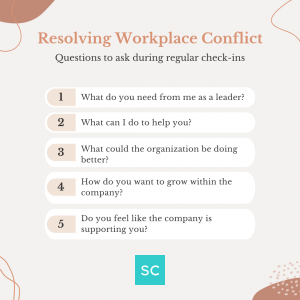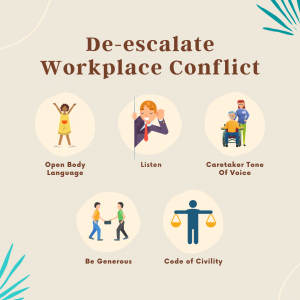Resolving Workplace Conflict
At some point in your career, conflict will arise. Knowing how to resolve workplace conflict will help you become a better leader and a trusted employee.
 Our CEO and Founder, Jessica Chen, recently hosted a Soulcast Media | LIVE event on LinkedIn where she interviewed author, and founder of Pollack Peacebuilding Systems, Jeremy Pollack.
Our CEO and Founder, Jessica Chen, recently hosted a Soulcast Media | LIVE event on LinkedIn where she interviewed author, and founder of Pollack Peacebuilding Systems, Jeremy Pollack.
They shared key tips and personal experiences about how to resolve workplace conflict. This Soulcast Media | Live event is brought to you by our amazing sponsors at Piktochart.
Piktochart is an easy-to-use visual content maker with more than 500 templates for you to choose from – ranging from infographics, presentations, reports, social media graphics, and more. Join more than 6 million people who are already using Piktochart to craft amazing visual stories.
1. Common Types of Conflicts Within The Workplace
Before you can resolve conflict, it is important to find out why there is conflict in the first place. In other words, what is the real reason behind the conflict?
There are several types of conflicts that commonly occur in the workplace. During the Soulcast Media | Live, Jeremy shared the most common reasons for conflict.
- Not feeling trusted
- Not trusting others
- Not feeling heard
- Not understanding how to hear/listen to others
- Unable to recognize or acknowledge someone else
These conflicts generally occur because a basic need isn’t being met. These needs include:
- Safety – Personal, psychological – being able to be one’s authentic self.
- Autonomy – Feeling like you have some agency or control in the way that you work. Feeling like your input is valued.
- Identity – human, social, and work identity – Do you feel like you are competent at what you do. Do you feel recognized for that competency?
- Connected – Feeling connected to people, making progress, and moving forward in a positive way.
- Feeling stimulated – Being challenged in a positive way.
Often times when there is conflict, it is because one or more of those needs is not being met. Or, there is conflict because someone feels like these basic needs are being threatened.
The key is to find out what is being threatened or not met and how to make things better.
2. Resolving Conflict
Finding the reasoning behind why there is conflict is the first step. The second step is resolving the conflict. This may be the most challenging. But the good news is, it can be done!
Wellnesss Check-ins – Doing regular one-on-one check-ins focusing on employee experience. If you are leading these check-ins, it is important that you don’t use this time for critical performance reviews. These check-ins are strictly to check in for a sense of employee well-being. Consider using these questions to help guide you:
- What do you need from me as a leader?
- What can I do to help you?
- What could the organization be doing better?
- How do you want to grow within the company?
- Is the company supporting you in this?

Addressing Behaviors – You may not be in a position of leadership, but you still need to address conflict because it can affect your performance i.e. dealing with a micromanager. During the Soulcast Media | Live, Jeremy shared how you can approach such a situation.
- Conversation – The power of conversation cannot be underestimated. The person who is exhibiting behavior you don’t appreciate isn’t able to fix it if they don’t know what is bothering you.
- Timeliness – You may need a day or two to process how you are feeling about a specific incident. However, you should try to be as timely as possible when speaking about a situation that made you uncomfortable or unhappy.
- Separate the behavior – When you talk about the situation, it is important that you separate the behavior from the person. Leave any judgments aside – and focus solely on the behavior.
- Be specific – As you talk about the behavior, you will want to be specific. For example – let’s say you have a manager who reviews every single slide of a presentation deck. You can say something like, “When you review every single part of my presentation, it makes me feel like I’m not being trusted or that you don’t trust me. It makes me feel like I’m not competent to do the work. I don’t know if that’s what you think, but that’s how it feels. Do you trust me to do the work?” When you approach it this way, you are allowing others to explain why they behave in that way.
- Collaborate – After you’ve shared the specific behavior that bothered you, you can then figure out how you can work together collaboratively to resolve how you are feeling. In this way, you both can work so that your manager understands how you feel and you can understand why your manager may look over your deck with such detail.
Solution building is collaborative.
3. De-escalating
During the Soulcast Media | Live, Jeremy was asked a question about how to de-escalate a situation. And while no one expects a large outburst, it can occur. If this ever happens, Jeremy offered a few strategies to help de-escalate a sensitive conflict.
Code of Civility– It is important that you have a code of civility within a group or organization. Collaborate together to create one if this is something that’s lacking. Make sure everyone in the company understands what is acceptable behavior in tricky situations and what isn’t. This will help prevent a conflict from getting out of control.
 Listen – Oftentimes people yell because they don’t feel they are being heard. If someone is yelling, it is your job to make sure that you are listening to them, despite how heated you may be too. That means you will want to let them know their concerns are important to you. Framing it like – that is really concerning or I want that for you too. Saying those words will help you become the agent or partner to the person who is feeling frustrated or angry. Engaging in reflective listening is also important. This means repeating what they’ve said so they feel like they’re being heard.
Listen – Oftentimes people yell because they don’t feel they are being heard. If someone is yelling, it is your job to make sure that you are listening to them, despite how heated you may be too. That means you will want to let them know their concerns are important to you. Framing it like – that is really concerning or I want that for you too. Saying those words will help you become the agent or partner to the person who is feeling frustrated or angry. Engaging in reflective listening is also important. This means repeating what they’ve said so they feel like they’re being heard.
Be Generous – Be the first to give in. If you value this relationship and you want to resolve the conflict, sometimes you have to be the one to make a concession. This doesn’t mean you are backing down. You are just giving air to the situation.
Tone Of Voice – Your tone of voice can have a large impact on how you are communicating. When trying to de-escalate the situation, embody the tone of voice of a caretaker – in other words, empathize with them and don’t talk in a demanding tone.
Body Language – You can also use your body language to help de-escalate a situation. Don’t square off with someone as in standing face to face because that can feel very oppositional. Slightly turning, not away from the person but very so slightly so that you’re both somewhat facing the same direction is ideal. It helps show that you’re on the same team and in this together. Sitting is also less oppositional than standing. Keeping yourself open is also important. Try not to close your fists, point your fingers, or cross your arms. Keep your hands open.
During the Soulcast Media | Live, Jessica shared that self-regulation and self-awareness are keys to de-escalation.
4. Resolving Conflict In A Remote Environment
Resolving conflict in the virtual world can be tricky, but as Jeremy shared during the LIVE event, resolving conflict in-person or on video utilizes much of the same interpersonal skills.
Start on a Macro – Talk about the psychology of conflict, what is going on, how it can be resolved. For example, when there is a conflict you can start by explaining why people have conflict. What needs aren’t being met or are being threatened. This is not pointing fingers, but rather giving an overview of what conflict is. Then, you can be more direct and talk about the current conflict and how it correlates to the psychology of conflict. For example, if one person is upset because they feel like they aren’t being valued, you can address this. After that, you can talk to both parties about collaboratively coming up with a solution.
Communication Sequences – giving and getting feedback using a sequence. For example, if someone comes to you with an issue, you know that first, you will talk about what needs aren’t being met. Then, you will address it, and then you will come up with a solution. Your communication sequence may look like this:
- Talk with party A about why they are having an issue.
- Talk with party B about the issue.
- Talk with HR regarding the issue.
- Bring A + B together to address the issue together
- Bring A, B, and HR together to discuss a collaborative solution.
When you have a predetermined sequence in place it makes it much easier for everyone involved to address the issue and come to a solution.
Separate behavior from interpretation – Even in a virtual environment, it is important to separate the behavior from your interpretation of it. This means that you are talking solely about a behavior, rather than the person or what you think the person is doing, and whether or not it is on purpose. For example, if you feel like your boss is micromanaging you, it is important that when you address your boss you point to the micromanaging behavior rather than them as a person. You can say, when you look over my deck line by line it makes me feel like you don’t trust me. This way you are being direct about the behavior and not assuming anything about your boss or his or her intentions.
In a hybrid working environment, it is still important to have tough conversations. You may not want to, but your work and the company culture will improve because of it. No one likes working when there is bad air.
Remember, if you want to resolve workplace conflict it is important that you first get to the root of the issue. Once you are able to identify the basic need that isn’t being met, you can much more easily come up with a solution.
If you would like to see the full LIVE version of Jessica and Jeremy’s conversation, check out Jessica’s Youtube Channel.
__
Whenever you’re ready, there are 3 ways we can help you:
- Discover your communications style so you know where to start. Over 4,000 people have found theirs here.
- Attend our monthly communication workshop to build communications confidence (new topics: public speaking, advocating for yourself, building credibility, etc) here.
- Get your brand in front of 43k+ people by sponsoring our newsletter or Soulcast Media | LIVE LinkedIn events [contact: hello@soulcastmedia.com]











